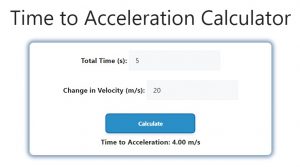About Time to Acceleration Calculator (Formula)
The Time to Acceleration Calculator is a useful tool that helps users determine how long it takes to reach a desired acceleration based on the initial and final velocities of an object. Understanding the relationship between time, velocity, and acceleration is essential in physics, engineering, and various fields of science. This calculator simplifies the process, allowing individuals to make quick and accurate calculations for their specific needs, whether in academic settings or real-world applications.
Formula
The formula for calculating time to reach acceleration is:
Time = (Final Velocity – Initial Velocity) / Acceleration
This formula indicates that time can be determined by finding the difference between the final and initial velocities and dividing that by the acceleration.
How to Use
Using the Time to Acceleration Calculator is straightforward:
- Input Initial Velocity: Enter the initial velocity of the object in meters per second (m/s).
- Input Final Velocity: Enter the final velocity of the object in meters per second (m/s).
- Input Acceleration: Enter the acceleration of the object in meters per second squared (m/s²).
- Calculate: Click the “Calculate” button to determine the time required to reach the specified acceleration.
Example
Let’s illustrate how to use the Time to Acceleration Calculator with an example:
- Initial Velocity: 10 m/s
- Final Velocity: 30 m/s
- Acceleration: 5 m/s²
Using the formula:
Time = (Final Velocity – Initial Velocity) / Acceleration
Time = (30 m/s – 10 m/s) / 5 m/s²
Time = 20 m/s / 5 m/s²
Time = 4 seconds
In this example, it would take 4 seconds to accelerate from 10 m/s to 30 m/s with an acceleration of 5 m/s².

FAQs
1. What is the purpose of the Time to Acceleration Calculator?
The calculator determines how long it takes to reach a certain velocity given the initial velocity and acceleration.
2. What units are used in the calculation?
The calculation uses meters per second (m/s) for velocity and meters per second squared (m/s²) for acceleration.
3. Can the calculator be used for negative acceleration?
Yes, the calculator can handle negative acceleration, which indicates deceleration.
4. What if I have a constant velocity?
If the initial and final velocities are the same, the time will be zero, indicating no change in velocity.
5. Is this calculator suitable for all objects?
Yes, as long as the required inputs (initial velocity, final velocity, and acceleration) are provided.
6. How does acceleration affect the calculation?
A higher acceleration results in less time to reach the final velocity, while lower acceleration increases the time.
7. Can I calculate time for multiple scenarios?
Yes, you can input different values to calculate time for various scenarios.
8. What is the significance of initial velocity?
The initial velocity sets the starting point for the calculation of time to reach the final velocity.
9. How accurate is the calculator?
The calculator provides accurate results based on the inputs provided, using standard physics formulas.
10. What is uniform acceleration?
Uniform acceleration refers to a constant acceleration over time, making calculations straightforward.
11. Can I use the calculator for non-linear motion?
This calculator is primarily for linear motion; non-linear motion requires different approaches.
12. What is the maximum velocity I can input?
There are no strict limits for velocity inputs, but practical limits may vary based on context.
13. How do I convert velocity from km/h to m/s?
To convert km/h to m/s, divide the speed by 3.6.
14. What does the result mean?
The result indicates the time taken to achieve the specified acceleration from the initial to final velocity.
15. How can I apply this knowledge?
Understanding time to acceleration is crucial in fields like automotive engineering, physics experiments, and sports performance analysis.
16. What if I don’t know the acceleration?
Without acceleration, you cannot accurately use this calculator, as it’s a necessary component of the formula.
17. Is this calculator useful for students?
Absolutely! It aids students in understanding the concepts of motion, velocity, and acceleration.
18. Can I use decimal values for velocity and acceleration?
Yes, the calculator accepts both integer and decimal values for accurate results.
19. How can I ensure correct input?
Make sure to double-check your values for initial velocity, final velocity, and acceleration before calculating.
20. What other calculations are related to acceleration?
Other related calculations include force, momentum, and kinetic energy, which also depend on acceleration and velocity.
Conclusion
The Time to Acceleration Calculator is an essential tool for anyone needing to understand the time required to reach a certain velocity under specified acceleration conditions. With its straightforward application, users can easily input their parameters and obtain quick, accurate results. This calculator not only aids in academic learning but is also valuable in practical applications across various fields, enhancing our understanding of motion and dynamics. Whether you are a student, engineer, or hobbyist, mastering this calculation can greatly benefit your understanding of the principles of physics.